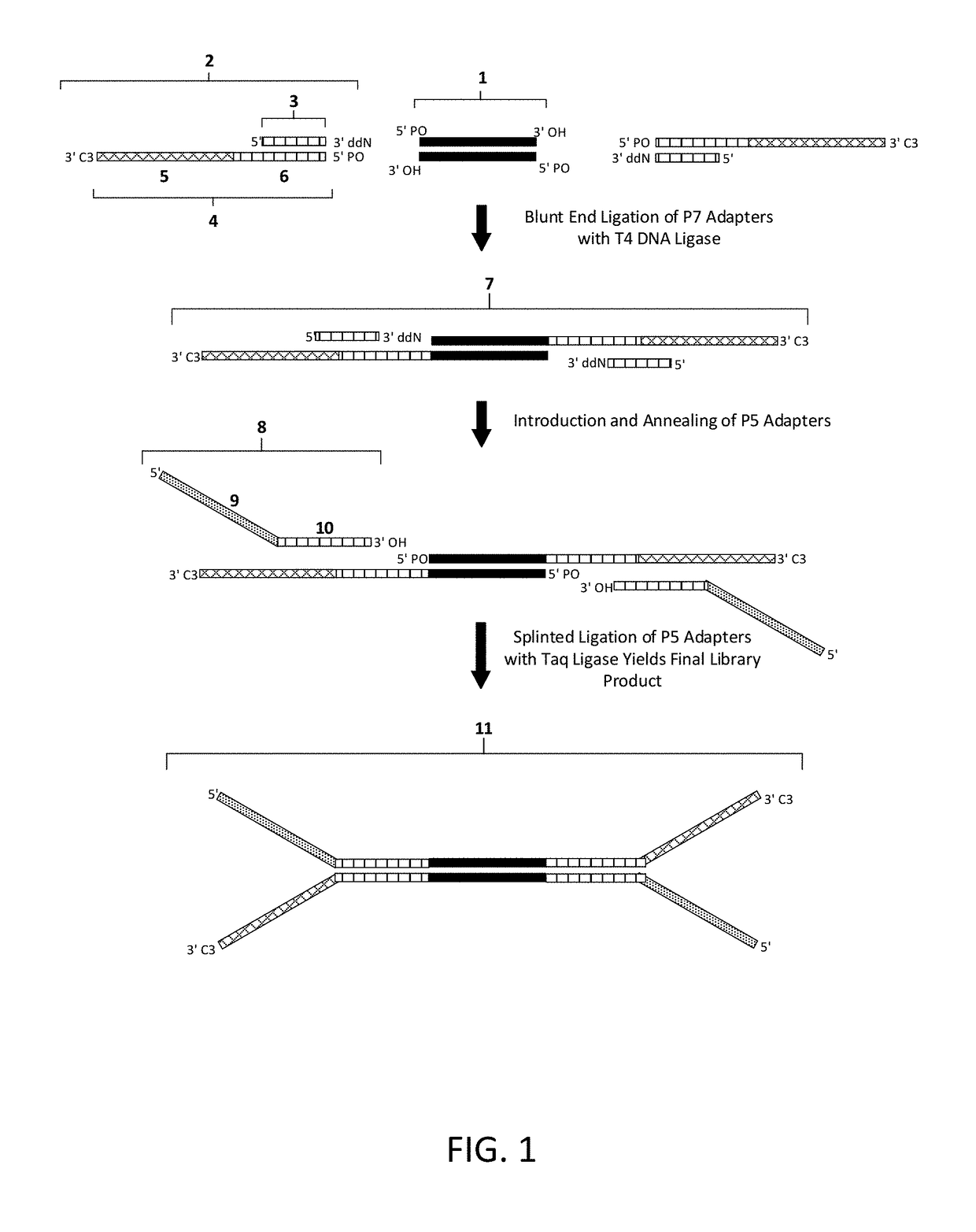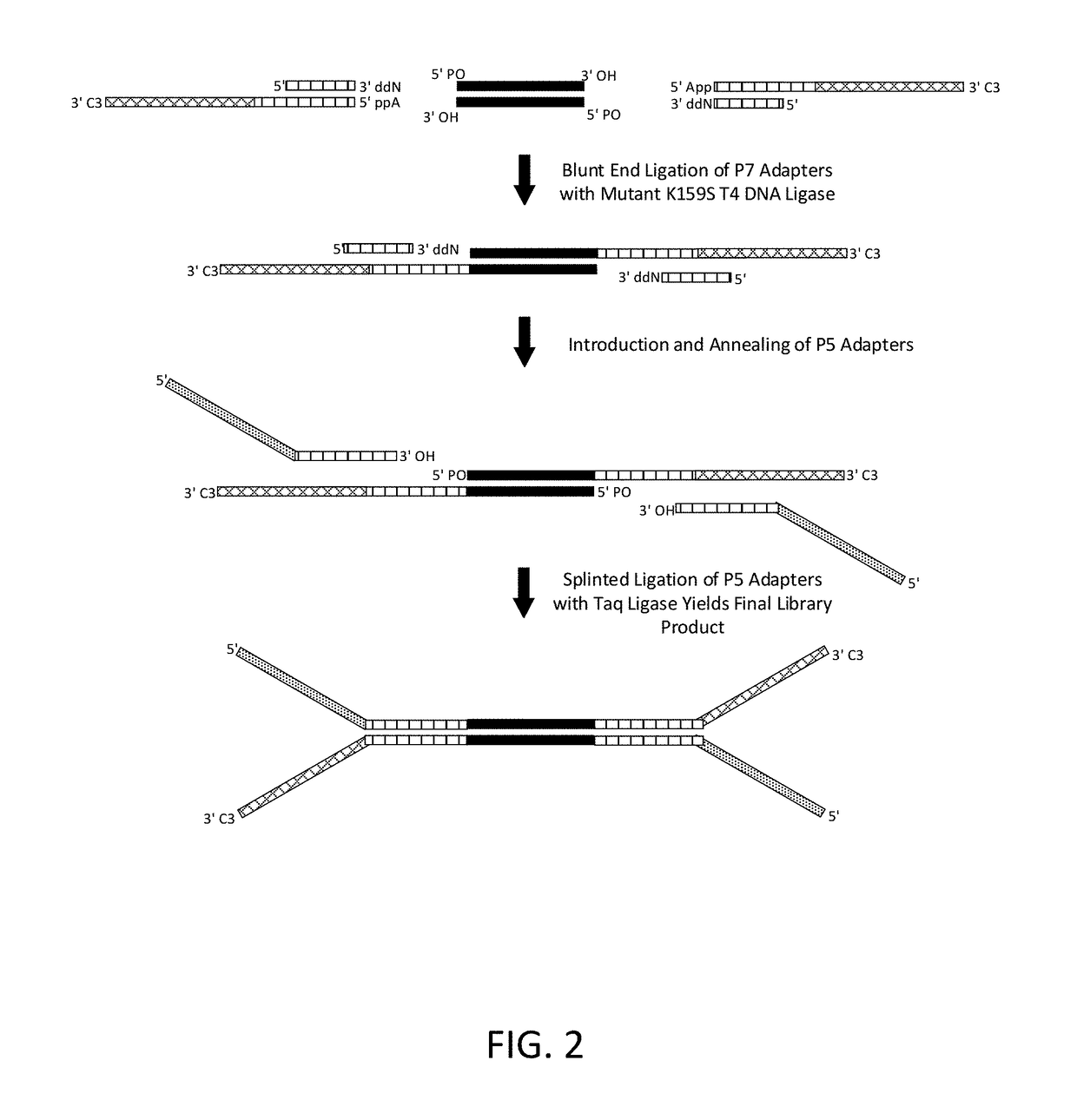Construction of next generation sequencing (NGS) libraries using competitive strand displacement
a strand displacement and strand technology, applied in the field of next-generation dna sequencing (ngs) libraries, can solve the problems of limiting the ligation efficiency of wild-type t4 dna ligase, unable to utilize atp to adenylate substrates, and unable to achieve ligation efficiency of wild-type t4 dna ligases, so as to achieve accurate conversion of dna samples into sequencing libraries, reduce formation
- Summary
- Abstract
- Description
- Claims
- Application Information
AI Technical Summary
Benefits of technology
Problems solved by technology
Method used
Image
Examples
example 2
[0050]This example demonstrates the enhanced depth of coverage obtained from NGS libraries, prepared from circulating cell free DNA (cfDNA), using the second embodiment of the CSD method as compared to that obtained when using the NEBNext® Ultra™ II library. “True” cfDNA samples are real cell-free DNA isolated by Biochain from healthy individuals, while “mock” cfDNA samples are cell-line genomic DNA (NA12878) sheared to 150 bp using a Covaris S2. Libraries were prepared with 1 ng of the cfDNA using the CSD and NEB methods, as described in Example 1, in triplicate. When compared with the NEB method, the average depth of coverage for CSD was 3.6× higher with the “true” cfDNA input, and 2.3× higher with the “mock” cfDNA input (FIG. 8C).
example 3
[0051]This example demonstrates the enhanced depth of coverage obtained from NGS libraries, prepared from low quality genomic DNA extracted from FFPE samples, using the second embodiment of the CSD method as compared to that obtained when using either the NEB Ultra II library. The FFPE samples were procured from Asterand Bioscience. Libraries were prepared as described above using 1 ng, 5 ng, or 10 ng of the FFPE derived genomic DNA, sheared to an average size of 200 bp, as starting material. When compared with the NEB method, the average depth of coverage for CSD was 1.8×, 1.4×, and 1.3× higher with the 1 ng, 5 ng, or 10 ng of the FFPE derived genomic DNA, respectively (FIG. 8D).
example 4
[0052]This example demonstrates the reduced chimera rate in NGS libraries prepared from cfDNA using the second embodiment of the CSD method as compared to that present in cfDNA libraries prepared using the NEB method. Libraries were prepared as described above, using 1 ng of “true” or “mock” cfDNA as input, in triplicate. When compared with the NEB method, the average % of chimeras present for CSD was 1.6× lower with the “true” cfDNA input and 1.8× lower with the “mock” cfDNA input (FIG. 9). The % chimera values were calculated based on the number of unique reads that were improperly aligned with the reference sequence (hg19). Fragments categorized as “chimeric” have either (1) paired reads that face the same direction (same orientation), (2) paired reads that align to regions of the reference sequence that are greater than 3 kb apart, and / or (3) paired reads that align to different chromosomes.
PUM
| Property | Measurement | Unit |
|---|---|---|
| Length | aaaaa | aaaaa |
Abstract
Description
Claims
Application Information
 Login to View More
Login to View More - R&D
- Intellectual Property
- Life Sciences
- Materials
- Tech Scout
- Unparalleled Data Quality
- Higher Quality Content
- 60% Fewer Hallucinations
Browse by: Latest US Patents, China's latest patents, Technical Efficacy Thesaurus, Application Domain, Technology Topic, Popular Technical Reports.
© 2025 PatSnap. All rights reserved.Legal|Privacy policy|Modern Slavery Act Transparency Statement|Sitemap|About US| Contact US: help@patsnap.com



